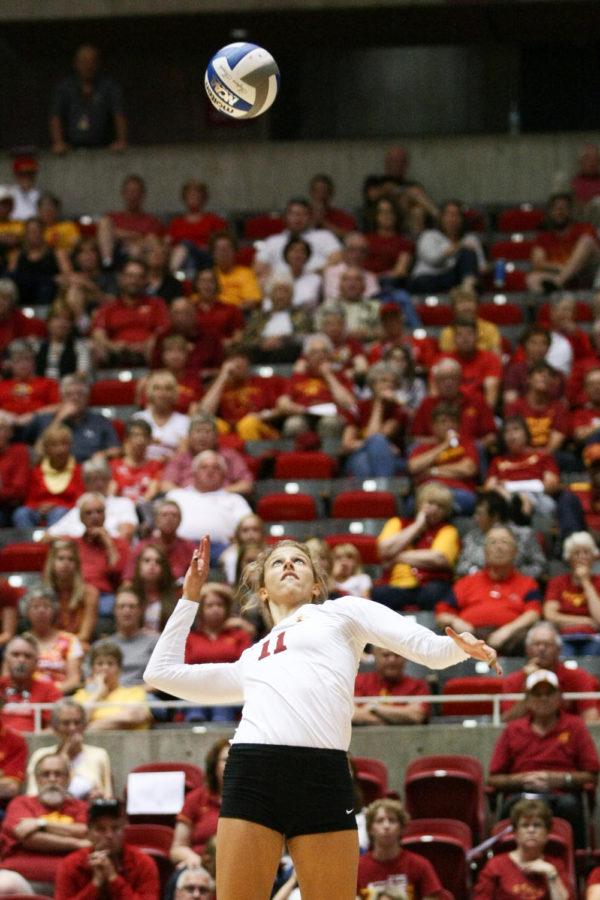Height, athleticism helps ISU volleyball
Sophomore outside hitter Ciara Capezio prepares to spike the ball toward the waiting Huskies during a set against Northern Illinois in the Iowa State Challenge on Sept. 6. The Cyclones defeated the Huskies in three straight sets.
September 9, 2014
Strategy, experience and execution all play important roles on a successful volleyball team, but as is the case in most sports, athleticism is the great equalizer.
Early in the season, as ISU head coach Christy Johnson-Lynch experiments with different lineups and attack strategies in search of her squad’s optimal identity, the ISU volleyball team (3-2, 0-0 Big 12) has relied on the athleticism of its front line to intimidate opponents and fill up the stat sheet.
“We have some really nice athletes and we have really good size at every position,” Johnson-Lynch said.
The ISU front line boasts 6-footers across the board. Former All-American Honorable Mention selections junior Mackenzie Bigbee and senior Victoria Hurtt stand 6-foot-1-inch and 6-foot-2-inch, respectively, and both have dynamic leaping ability at the hitter position.
They are complimented by 6-foot-3-inch sophomore hitter Ciara Capezio, who has come on strong early in the season after battling back from surgery in February to remove a pinched nerve in her foot.
“It was a tough first season for [Capezio] and we asked a lot of her,” Johnson-Lynch said. “I think she is just that much more prepared this year.”
Capezio tallied 38 kills for the Cyclones in the course of three ISU victories in the Iowa State Challenge, including 17 kills against Northern Illinois in the final match of the weekend.
“She was kind of in the zone [Sept. 6],” Johnson-Lynch said of Capezio. “We have really asked her to be low error, so we focus on that every day in practice.”
Minimizing errors is a key aspect to the art of the attack, which Capezio said is more complicated than simply sprinting to the net and hammering the volleyball down onto the other side of the court.
Attacks come in various forms, including the go, the four and the gap, all of which are designed to exploit a particular area of the opposing defense.
“I’ve learned that there is so much more to the game. It is not just your side. It is reading the other side,” said freshman middle-blocker Alexis Conaway, who has stepped into a prominent role on the front line early in her career. “I’ve been working on being smarter and learning when you should take those swings.”
The 6-foot Conaway has already built up a reputation for flying around the court making acrobatic plays. She said it is hard to discern how much of the split-second decision making process, which happens in mid-air, relies on conscious thought and how much of it relies on pure instinct.
“The more you play, the more your thoughts just become instinct in the game,” Conaway said. “My goal is to be available all the time and be aggressive. Once you are, those other shots will open up.”
Johnson-Lynch said that as important as practice and guidance are to Conaway and her front-court counterparts, much of what they exhibit during matches is rooted in inherent skill.
“A lot of what [Conaway] does is just natural instinct and not necessarily coached,” Johnson-Lynch said. “Her athletic ability allows her to do some pretty special things and we have several athletes like that on the court now.”
Capezio said the mentality and production of the entire front-line adds a dimension of intimidation to the Cyclones’ arsenal, as opponents get a first-hand preview of what they must overcome during warm-ups.
“It is a great quality that we have,” Capezio said. “Many teams kind of just play and they do not have that bond to push each other. We push each other just as hard in practice as we get pushed in games.”







